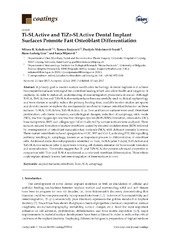Приказ основних података о документу
Ti-SLActive and TiZr-SLActive Dental Implant Surfaces Promote Fast Osteoblast Differentiation
| dc.creator | Kaluđerović, Milena | |
| dc.creator | Krajnović, Tamara | |
| dc.creator | Maksimović-Ivanić, Danijela | |
| dc.creator | Graf, Hans-Ludwig | |
| dc.creator | Mijatović, Sanja | |
| dc.date.accessioned | 2019-04-03T09:03:01Z | |
| dc.date.available | 2019-04-03T09:03:01Z | |
| dc.date.issued | 2017 | |
| dc.identifier.uri | http://www.mdpi.com/2079-6412/7/7/102 | |
| dc.identifier.uri | https://radar.ibiss.bg.ac.rs/handle/123456789/3307 | |
| dc.description.abstract | A primary goal in modern surface modification technology of dental implants is to achieve biocompatible surfaces with rapid but controlled healing which also allow health and longevity of implants. In order to realize all, understanding of osseointegration phenomena is crucial. Although Ti-SLA, Ti-SLActive and TiZr-SLActive surfaces have been successfully used in clinical implantology and were shown to notably reduce the primary healing time, available in vitro studies are sparse and do not concern or explore the mechanism(s) involved in human osteoblast behavior on these surfaces. Ti-SLA, Ti-SLActive, TiZr-SLActive, Ti cp, Ticer and Cercon surfaces were used. Osteoblast proliferation, cell cluster formation, morphological changes, induction of autophagy, nitric oxide (NO), reactive oxygen species/reactive nitrogen species (ROS/RNS) formation, osteocalcin (OC), bone sialoprotein (BSP) and collagen type I (Col-1) affected by various surfaces were analyzed. These surfaces induced formation of mature osteoblasts caused by elevated oxidative stress (ROS) followed by overexpression of osteoblast maturation key molecule (NO), with different intensity however. These mature osteoblasts induced upregulation of OC, BSP and Col-1, activating PI3/Akt signalling pathway resulting in autophagy, known as an important process in differentiation of osteoblast cells. Additional distinctive subpopulation identified on Ticer, Ti-SLA (after 5 days), Ti-SLActive and TiZr-SLActive surfaces (after 2 days) were forming cell clusters, essential for bone noduli formation and mineralisation. The results suggest that Ti- and TiZr-SLActive possess advanced properties in comparison with Ticer and Ti-SLA manifested as accelerated osteoblast differentiation. These effects could explain already known fast osseointegration of these surfaces in vivo. | en |
| dc.relation | info:eu-repo/grantAgreement/MESTD/Basic Research (BR or ON)/173013/RS// | |
| dc.relation | ZL Microdent, Germany (KF2036702SU9) | |
| dc.rights | openAccess | |
| dc.rights.uri | https://creativecommons.org/licenses/by/4.0/ | |
| dc.source | Coatings | |
| dc.subject | Implant surfaces | |
| dc.subject | Osteoblast | |
| dc.subject | Ticer | |
| dc.subject | SLA | |
| dc.subject | Autophagy | |
| dc.title | Ti-SLActive and TiZr-SLActive Dental Implant Surfaces Promote Fast Osteoblast Differentiation | en |
| dc.type | article | en |
| dc.rights.license | BY | |
| dcterms.abstract | Мијатовић, Сања; Калуђеровић, Милена; Крајновић, Тамара; Максимовић-Иванић, Данијела; Граф, Ханс-Лудwиг; Ти-СЛAцтиве анд ТиЗр-СЛAцтиве Дентал Имплант Сурфацес Промоте Фаст Остеобласт Дифферентиатион; | |
| dc.rights.holder | © 2017 by the authors | |
| dc.citation.issue | 7 | |
| dc.citation.volume | 7 | |
| dc.identifier.doi | 10.3390/coatings7070102 | |
| dc.identifier.scopus | 2-s2.0-85057112873 | |
| dc.identifier.wos | 000407452700019 | |
| dc.citation.apa | Kaluđerović, M., Krajnović, T., Maksimović-Ivanić, D., Graf, H.-L., Mijatović, S., Kaluđerović, M. R., … Mijatović, S. (2017). Ti-SLActive and TiZr-SLActive Dental Implant Surfaces Promote Fast Osteoblast Differentiation. Coatings, 7(7), 102. | |
| dc.citation.vancouver | Kaluđerović M, Krajnović T, Maksimović-Ivanić D, Graf H-L, Mijatović S, Kaluđerović MR, Krajnović T, Maksimović-Ivanić D, Graf H-L, Mijatović S. Ti-SLActive and TiZr-SLActive Dental Implant Surfaces Promote Fast Osteoblast Differentiation. Coatings. 2017;7(7):102. | |
| dc.citation.spage | 102 | |
| dc.type.version | publishedVersion | en |
| dc.identifier.fulltext | https://radar.ibiss.bg.ac.rs//bitstream/id/4904/Coatings_2017_7_7_102.pdf | |
| dc.citation.rank | M21 |

